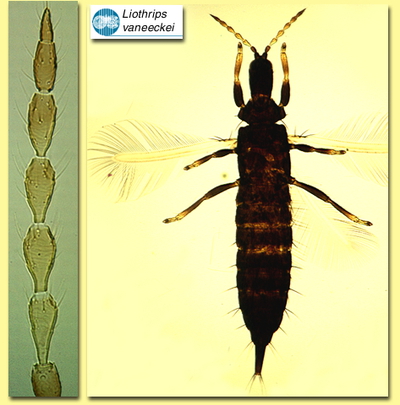Figures
Fig. 1 Antenna, head, thorax and abdomen
Fig. 2 Head (dorsal)
Fig. 3 Pronotum
Fig. 4 Prosternal plates
Fig. 5 Fore wing
Fig. 6 Tergite IX and X (tube, male)
Species
Liothrips vaneeckei PriesnerBiology
Breeding on the bulbs of certain lilies and orchids; sometimes reaching pest levels.
Distribution
Widely distributed by the horticultural trade, but only locally common.
Recognition
Body colour dark brown; antennal segment III yellow, also all tarsi, fore tibiae and distal half of mid and hind tibiae; forewings mainly clear but with a light brown longitudinal marking. Head longer than wide, postocular setae long and pointed. Antennae 8-segmented, III with 1 sense cone, IV with 3 sense cones. Pronotum with 5 pairs of long pointed setae. Forewings with about 9 duplicated cilia on posterior margin. Fore tarsi with no tooth. Tergites each with 2 pairs of sigmoid wing-retaining setae; IX with 3 pairs of long pointed setae; tube about 0.8 times length of head. Male similar to female; sternite VIII with broad glandular area; tergite IX setae B1 pair short and stout.
Related species
The genus Liothrips contains about 230 described species, although in the Australian region many similar species but with rather shorter setae are commonly referred to a further genus, Teuchothrips. Members of both genera are largely host specific, and few are recorded as pests. Species recognition in this group remains very difficult, but the lily bulb thrips is unusual in having the mid and hind tibiae sharply bicoloured.







